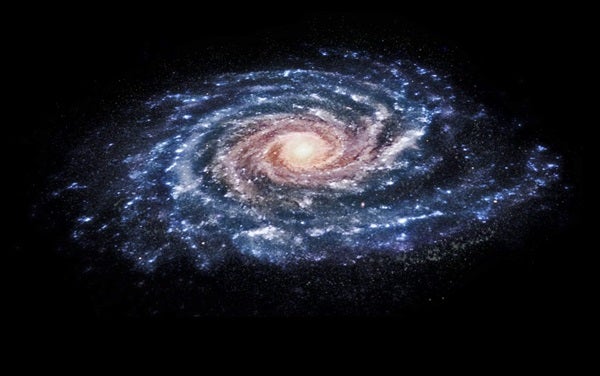The Milky Way likely collided with the newfound dwarf galaxy Antlia 2 less than a billion years ago, according to new research presented Wednesday at the 234th Meeting of the American Astronomical Society.
The research, spearheaded by
Sukanya Chakrabarti of the Rochester Institute of Technology, supports a prediction she made a decade ago about how the Milky Way obtained a unique “ripple” pattern in its outer disk. If confirmed, the researchers think the discovery will make Antila 2 an ideal natural laboratory for investigating the elusive substance known as dark matter. The work has been submitted for publication to the
Astrophysical Journal Letters; a
preprint is currently available.
Cosmic whodunit
Back in 2006, researchers revealed the Milky Way has a strange set of ripples percolating through its outer gas disk. In 2009, Chakrabarti published a
study that analyzed these ripples, showing a collision between a dark-matter dominated dwarf galaxy and the Milky Way could explain how they formed.
To find the culprit, her team first rounded up the usual suspects: known satellites of the Milky Way like the Magellanic Clouds and the Sagittarius Dwarf Galaxy. However, the Magellanic Clouds are too far away and Sagittarius Dwarf has too little heft to explain the fingerprints left in our galaxy. This led Chakrabarti to predict that another dwarf galaxy — one that hadn’t been found at the time — was responsible for the galactic drive-by.
Fast forward to last year, when researchers using the second release of data from the Gaia satellite (called Gaia DR-2) uncovered a previously unknown, faint dwarf galaxy orbiting near the outskirts of the Milky Way:
Antlia 2. The galaxy, which is located about 400,000 light-years away and is about as wide as the Large Magellanic Cloud, is also basically invisible. In fact, according to Chakrabarti, it’s currently the galaxy with the lowest known surface brightness (a measure of a galaxy’s light per area of the sky that it covers).
Chakrabarti set out to see whether this newly found galaxy could truly be the elusive dark matter-dominated dwarf she predicted nearly a decade ago. To test her theory, she calculated the past trajectory of Antlia 2 based on its movement and location now. Lo and behold, Antlia 2 does indeed appear to have smashed into the Milky Way in the past.
“The orbit of Antlia 2, as derived from Gaia DR-2 data, does bring it within [about 32,000 light-years] of the galactic center,” Chakrabarti told Astronomy. “The outer parts of the Milky Way then show the perturbations [ripples] for about 500 million years or so.”
But just how well do the real ripples compare to those produced by a simulated collision between our galaxy and Antlia 2? As Chakrabarti told Astronomy, “It’s almost dead on.”
Before Chakrabarti and her team can be certain, though, they will need to wait for the next batch of data from the Gaia mission, which is working to map over a billion stars in the Milky Way. The new data will allow the researchers to test their “hand-on-the-cutting-board kind of prediction,” Chakrabarti says, for how the stars within Antlia 2 should currently be moving. If the motions line up with the predictions, it should clinch the case for Antlia 2 as the cause of our galaxy’s ripples.
This simulation shows the collision between Antlia 2 and the Milky Way, starting 3 billion years in the past and running until present day. The right side shows the galaxies with their stars, and the left side shows just the gas (Ant 2 doesn’t have any noticeable gas). According to the author, on the left side, you can see the collision reproduces the observed ripple’s in the Milky Way’s gas disk “almost dead on.”
Sukanya Chakrabarti/RIT
Probing dark matter
If their theory is confirmed and Antlia 2 really turns out to be the galaxy that disrupted the Milky Way’s gas, it may open the door to using Antlia 2 to help us investigate dark matter.
“If Antlia 2 is the dwarf galaxy we predicted, you know what its orbit had to be. You know it had to come close to the galactic disc. That sets stringent constraints, therefore, on not just the mass, but also its density profile [the distribution of matter, both normal and dark, throughout the galaxy],” Chakrabarti said in a
press release. “That means that ultimately you could use Antlia 2 as a unique laboratory to learn about the nature of dark matter.”
In other words, by looking at the result of its crash into our galaxy, researchers could determine how dark matter is spread throughout Antlia 2. And with that information, Chakrabarti told Astronomy, “you can now start to tell the difference between different dark matter models.” That would certainly bring astronomers one step closer to understanding the elusive nature of dark matter — one of the greatest unsolved mysteries in the field today.










